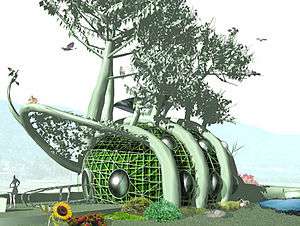Fab Tree Hab

The Fab Tree Hab is a hypothetical ecological home design developed at MIT by Mitchell Joachim, Javier Arbona and Lara Greden. With the idea of easing the burden Humanity places on the environment with conventional housing by growing "living, breathing" tree homes.[2]
It would be built by allowing native trees to grow over a computer-designed (CNC) removable plywood scaffold. Once the plants are interconnected and stable,[1] the plywood would be removed and reused. MIT is experimenting with trees that grow quickly and develop an interwoven root structure that's soft enough to "train" over the scaffold, but then hardens into a more durable structure. The inside walls would be conventional clay and plaster.
An old methodology new to buildings is introduced in this design - pleaching. Pleaching is a method of weaving together tree branches to form living archways, lattices, or screens. [3] One of the companies giving advice on the use of Aeroponic culture with pleaching is Plantware[2] The load-bearing part of the structure is to use trees that self-graft or inosculate such as Live Oak, Elm and Dogwood. The lattice frame for the walls and roof are created with the branches of the trees. Using vines to create a dense protective layer woven along the exterior, interspersed with soil pockets and growing plants. To increase the control, depth and accuracy of this building method a conventional computer designs the scaffold use to grow the plants on. [1]
The Fab Tree Hab is an experiment that would develop over time. Extra operating costs required over the life-time of the home include pest management with organic pesticides and maintenance of the living machine's water treatment system. Technical demonstration and innovation is still needed for certain components, primarily the bioplastic windows that accept growth of the structure and the management of flows across the wall section to assure that the interior remains dry and animal-free. All in all, the elapsed time to reach livability is greater than the traditional sense, but so should be the health and longevity of the home and family. Above all, building this home could be achieved at a minimal price. Depending on the surrounding climate the house is to be grown in, the team expect it will take a minimum of five years to complete its structure.[2][1]Realization of these homes will begin as an experiment, and it is envisioned that thereafter, the concept of renewal will take on a new architectural form - one of inter-dependency between nature and people.
As of May 2007 Mitchell Joachim stated that there is a "50 per cent" organic project in California. Combining natural elements and traditional construction. [2]
Trees
Main trees suggested to be used are elms and oaks. The teams hopes the homes can be grown using mainly native trees. [1]
See also
References
- 1 2 3 4 5 Mitchell Joachim. "Terreform One". Retrieved 2015-11-06.
- 1 2 3 4 "Grow your own home: 'Fab tree hab'". Retrieved 2015-11-06.
- ↑ Tracy Staedter. "Architects design a living home". Retrieved 2015-11-06.
Further reading
- James Nestor, "Branching Out," Dwell, Vol. 7 No. 3, pp. 96–98, Feb. 2007.
- Gregory Mone, "Grow your second home," Popular Science, pp. 38–9, Nov. 2006.
- Carolyn Johnson, "MIT plants seeds of a new kind of house" , The Boston Globe, p. C1, Sept. 25th, 2006.
- Tracy Staedter, “House and Garden - Architects design a living home," Technology Review, pp. m2-m9, VOL. 109/ NO.3, July/ August, 2006.
- Gail Hennessey, "Living in the Trees, " Scholastic News, Mar. 9, 2006.
- Linda Stern, "Beware of Squirrels," Newsweek , p. E2, May 28, 2007.
- Mitchell Joachim, Javier Arbona, and Lara Greden. "Fab Tree Hab," 306090 08: Autonomous Urbanism, Monson & Duval, ed., Princeton Architectural Press, 2005.
- Richard Reames, Arborsculpture- Solutions for a Small Planet, Arborsmith Studios, 2005 ISBN 0-9647280-8-7.
- David J. Brown, Ed., The HOME House Project: The Future of Affordable Housing, MIT Press, 2004.
- Mitchell Joachim, J. Arbona, L. Greden, "Fab Tree Hab," Thresholds Journal #26 DENATURED, MIT, 2003.
External links
- Popular Science: Grow Your Second Home at the Wayback Machine (archived March 23, 2014)
- Newsweek: Terreform - Building Houses Out of Living Trees
- MIT Architecture: Computation WORKS
- Arborsmith Studios- Shaped trees, history, books, tools
- 5 minute Video talk Mitchell gave at TED